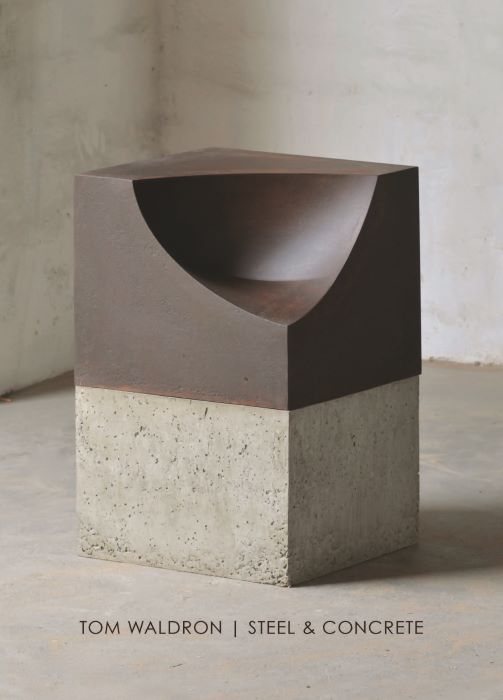
The eye follows a smooth plane, curving gently in pitch, slope on slope, sweeping to meet and create a line. A deep rust form tilts, leaning, forming a deeply shadowed side. A sharp, faceted arc sweeps to a point. Softly interwoven curves braid together in a column. A round oxidized shape seems to fold up on itself, caught in a moment just before it sprouts wings.
It is a trick of sculpture to put us squarely into the here and now. Mass. Volume. Weight. Sculptures inhabit space with us and we with them. They alter the air’s flow through a room. They radiate their own minute gravity. Fully art object, whether molded or cast, carved or welded, sculptures remind us that our world is multi-dimensional – not solely existing in the 2D hybrid mind/light no-space of our screens.
Tom Waldron’s work not only brings us to attention but challenges our perceptions with its deceptively simple forms. It is likely no surprise that Waldron’s entrance into artmaking was spurred by his love of the materiality and physicality of the process. The challenge and intense focus required of welding, its possibilities and generative power led Waldron to leave his studies in architecture to pursue
sculpture.
Steel and Concrete brings together a disparate collection of Waldron’s work in different mediums. While he is best known for his steel
pieces, this show also incorporates works in concrete, a dense gypsum plaster (Hydro-stone), and even in wood. The concrete and wood pieces have evolved slowly in relationship to the steel works. First, as simply materials for pedestals and bases. However, over time, sometimes the line between sculpture and pedestal would blur. Later, Waldron began to take some of the curved cardboard constructions that he creates as models for his steel works and use them as molds to cast concrete or hydro-stone pieces. In this format, Waldron saw the possibilities of using them like modules. Using wood allowed Waldron to explore wall-mounted work because of its lighter weight –
but the medium also allowed him freedom to alter and find forms not possible in steel.
The pieces in Steel and Concrete, in each medium exemplify these different properties and effects – the steel pieces with their gently curved volumetric masses tend to encapsulate or bloom into space. Sledge, at over eight feet, and Agave, at five, seem like massive geometric creatures frozen in a moment of twisting growth. Ledge 2 tricks the eye into seeing a rectangular block from one angle –
which then bulges and puckers from another. Mounted on a concrete base, Spoonful, inverts Waldron’s more familiar convex curves with a smooth concave scoop out of the sharp-edged steel square.
The concrete pieces included in the exhibition are all columnar – composed of regular interlocking shapes and modules which showcase the motion of uprising lift and rhythm. Shadow Column includes both a wood base and cap which contain a smooth, white, braided sculpture of hydro-stone within. Fan Column, on its wood plinth, is a complex composition of interlocking arced forms in alternating
muted colors. His most recent piece, Six Color Column is comprised of gently curved blocks fitted together to create an undulating tower.
Finally, the wood piece, White Cloud 3, explores the same fascination with curved planes and elegantly intersecting lines as Waldron’s steel works – but makes good use of its lighter weight to create a more delicate shape that seems to sail out abstractly from the wall.
Step by step, each sculpture of Steel and Concrete leads the viewer through an experience, from objective observation through to subjective
co-existence. Frozen curves intimate at the gentle slowing down of time. (We pause. We notice.) The density of the large steel works grounds our feet into the floor. (We find balance in space as they balance so elegantly in their twisted curved forms.) And the columns, rising slenderly toward human height, feel like fellow beings. (We stand with them, being.)
— Michaela Kahn, Ph.D.

